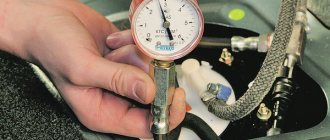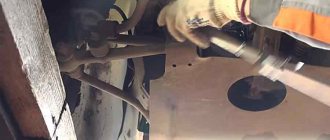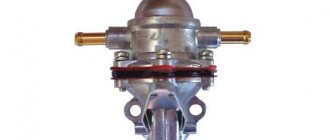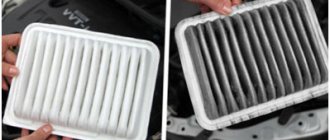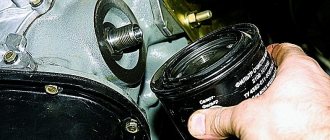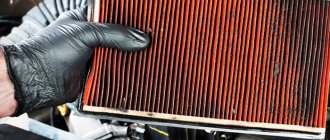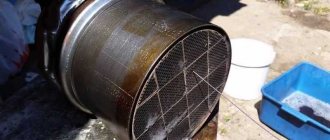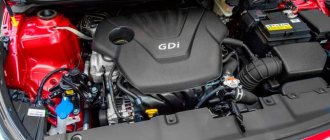One of the most important tasks in a car’s fuel system is performed by the fuel pump, or as it is also called the fuel pump. It is he who supplies fuel through the fuel system and a lot depends on him. The VAZ injection system has an electric fuel pump located in the tank. We will tell you in detail how to replace the fuel pump on a VAZ 2110-2112 in this article.
Today I disassembled the pump, removed the old connector and gasket, the connector was also cracked and the gasket was like a rag. 30 minutes of my torment, I finally put on another connector and gasket, and installed the nuts, which did the trick.
Signs of a malfunctioning fuel pump (gasoline pump)
One of the main symptoms by which you can safely determine the need to replace the fuel pump is poor engine draft in the absence of other obvious reasons. Over time, the fuel pump pumps less fuel, and as a result, the pressure in the system drops, which means the engine's thrust deteriorates.
To verify that the fuel pump is faulty, measure the pressure in the fuel system (rail). If the pressure is low, then either the fuel pump or the check valve is responsible for the pressure in the system.
A damaged pump can be very loud and the sound will be clearly audible. This could be another sign of a dying pump.
Is it possible to damage the fuel pump?
Yes, you can, the fuel pump is constantly immersed in fuel, if there is little or no gas in the tank, the fuel pump will run “idling”, and as a result there is a high probability of failure.
Signs of a fuel pump malfunction
An experienced car enthusiast can determine the malfunction of his car by its behavior or by extraneous sounds. This also applies to the fuel pump. If knowledge is not enough, it is worth considering the following characteristic signs indicating problems with the fuel pump:
- the engine does not start;
- the engine stalls almost all the time;
- the power and dynamics of the car decreases.
However, it is worth considering that power may decrease for a number of other reasons: problems with piston rings, valves, etc. If the fuel pump is completely faulty, the engine will not be able to start.
The fuel pump does not pump
There may be several reasons why the device does not supply fuel. Before you start troubleshooting, you need to make sure that there is gasoline in the tank. It happens that the level sensor shows incorrectly and the problem simply comes down to a lack of fuel. You also need to make sure that the filter elements are not clogged, but it is better to replace them, because they are inexpensive. After these steps, you can begin diagnostics.
Due to clogged fuel filters, the pump cannot supply the required amount of fuel to the carburetor.
The causes of problems may be:
- wear due to long mileage;
- diaphragm damage;
- insufficient spring stiffness as a result of stretching;
- valve contamination;
- violation of the tightness of the unit.
If the gas pump on the “seven” does not supply fuel, then there are two ways out of this situation: install a new device or disassemble the old one, carry out diagnostics and replace damaged parts.
On my car, a situation once arose that indicated a lack of fuel for the engine: there was no normal dynamics, the engine periodically stalled and would not start. There was enough gasoline in the tank, the filters were in good condition, but the car did not drive. After lengthy investigations and clarification of the reasons for this phenomenon, the problem was found: the fuel supply hose from the pump to the carburetor was swollen inside, which indicated the poor quality of the product. The internal cross-section has become very small and insufficient to pass the required amount of fuel. After replacing the hose the problem disappeared. In addition, I change fuel filters at least every 5 thousand km. mileage (preferably more often). I have them before and after the fuel pump. As practice shows, even with the installation of two filters, as well as with a mesh in the fuel pump itself and at the carburetor inlet, debris still penetrates into the float chamber. This results in the carburetor having to be cleaned periodically.
Which fuel pump to choose for replacement
A BOSCH 580454138 fuel pump is installed from the factory. Its service life depends on the quality of the fuel used, as well as on operating conditions. It is also worth noting that this pump is suitable for most other cars, including foreign ones. The price of a BOSCH fuel pump at the moment is from 1,700 rubles. There are cheaper analogues on the market:
- WEBER FP 453-453 from 600 rub.
- ATS 2112-1139010 from 550 rub.
- PEKAR 2112-1139010 from 600 rub.
- FENOX EFP35005O7 from 700 rub.
- HOFER HF 830301 from 550 RUR
- StarTVOLT SFP 0153 from 750 rub.
- VOLTON VLT2112-1139010 from 650 rub.
Each of the fuel pumps listed above are suitable replacements for the original, but not all are of the same quality as the original. In addition to the pump itself, the inverter may need to be replaced, and if the fuel pump retaining ring is damaged, it can be ordered or purchased using the following number:
- Ring electric / fuel pump / 2110 / metal price from 120 rub.
- Fuel pump air duct / 2110 / 1.5 white from 50 rubles per piece
- Fuel pump stand / 21101 / 1.6 long - from 60 rub. A piece
If you decide to replace the entire fuel module assembly, you can choose from one of the modules suggested below.
- Electric fuel pump module / 21101 / V = 1.6 assembled Pekar price from 2500 rub.
- Fuel pump bushing / 21101 / B = 1.6 assembled “Cliff” price from 3200 rub.
- Fuel pump bushing / 21102 / B = 1.5 assembled “Cliff” price from 3000 rub.
- Electric / fuel pump module / 21102 / V = 1.5 assembled HOFER price from 2000 rub.
If you decide to replace only the fuel pump, we recommend that you immediately carry out a full check of the module - check the check valve and both bellows, and replace the fuel strainer if necessary.
Instructions for replacing the fuel pump
First, move the rear seat to the side and remove the piece of carpet covering the fuel module hatch.
Then unscrew the two fastening screws of the damper and remove it.
A fuel module with two tubes will be visible in front of us.
Before disconnecting hoses, relieve pressure in the fuel system. To do this, remove the fuel pump fuse or turn off the power to the module and start the engine. When the remaining fuel in the system runs out, the car will stop and you can begin replacing the fuel pump.
The fuel module can be of different types - quick-connect and bolt-on, depending on the year of manufacture of the car. If the fuel lines are on nuts, unscrew them with a 17mm wrench. If on quick connects, simply tighten the clamps and remove them from the module.
Now remove the 8 bolts securing the fuel module clamp using a 7mm wrench or socket.
Unscrew the fuel lines from side to side, lift the clamp and carefully pull out the fuel module so as not to spill gasoline.
Disconnect the fuel pump plug.
Remove the latch (picture below).
Remove the two screws with a flat head screwdriver.
Remove the rubber bushing and the plastic piece underneath.
You can now remove the fuel pump from the module and replace it with a new one.
To install and reassemble the new fuel pump, install a new ribbed hose onto the pump. In order for this hose to be sealed when it is connected to the pump, it must be heated.
Then reassemble in reverse order.
How to clean the fuel pump yourself
So, the fuel pump is located in the fuel tank. Modern cars are equipped with a fuel station, where a large plastic “glass” on which the pump and fuel level sensor are mounted, also acts as a filter. A coarse filter is attached to the pump, on which dirt and other large deposits remain.
So, the process of cleaning the pump and mesh occurs as follows:
- Since the fuel pump is located directly in the gas tank, you need to get to it through the passenger compartment or trunk. Depending on the design, the fuel station cover may be located under the seat of the rear sofa, or under the false trunk floor. For this procedure, you need to equip yourself with a minimum set of tools;
- Next, we find the cover, and before removing it, be sure to clean it of dust and dirt, as well as the area around it, so that nothing gets into the gas tank;
- Then we relieve the pressure by releasing the fuel pressure. On the cover you will see the fuel pump power connector, which must be removed. Now we operate the starter for a few seconds until all the fuel is pumped into the cylinders;
- Now we remove the negative terminal from the battery in order to remove the connectors from the fuel pipes (one pipe is the fuel supply, the second is the return). How to properly remove the tube clamps - refer to the repair and operating instructions for your car;
- If your hatch is structurally equipped with a pressure ring, then it is impossible to unscrew it by hand, so you will have to use a special puller. If there is no such device, then the cover can be removed by adding a flat-head screwdriver and tapping it with a hammer, the main thing is not to overdo it, so as not to break the cover. Stock up on the cover gasket in advance;
- before removing the fuel pump, allow the fuel to drain into the tank, and then cover the tank to prevent unwanted products from getting into the fuel;
- start disassembling the pump. For the pump, it is necessary to remove the lower part of the housing, where all the dirt settles;
- then remove the mesh from the pump; to do this, just dig under the filter retaining ring;
- Assess the condition of the fuel grid; if it is completely clogged, it is likely that the fine fuel filter will have to be changed, and it is advisable to wash the injectors. Remember that due to a clogged filter, the fuel pump overcomes strong resistance, causing it to overheat and fail;
- if the mesh is dirty on the surface, then clean it with a special spray, such as carburetor cleaner, rinse it until the outside of the mesh is clean. Next, blow it out with compressed air. In another case, we simply change the grid to a new one, preferably the original one;
- The final stage is the assembly and installation of the fuel station in its place. We install the pump in the reverse order, and if the level indicator, after turning on the ignition, begins to show the wrong amount of fuel - do not be alarmed, after one refueling the sensor adapts itself.
